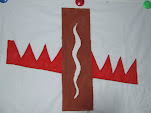Esis's Chronicles 172
Origin of The Midsummer Fire ©
This blog a ‘break’ in the regular series.
Johns Eve or the Midsummer Festival in Latvia is only
weeks away. Here are some reflections on the significance of the festival by
one who many years ago became an afficianado of the festival and has never been
able to let go of an interest in it..
The sad truth about the demise of the Latvian Midsummer Festival is that it is not the result of Soviet repression (as many allege, but a consequence of the Latvian intelegentsia smothering its own communal roots by surrendering to the neo-Christian propaganda about God being a Being out of nature.
The smothering of this ‘day of the community’ has other sources as well. One cause is an overly tight hugging of Johns as a purely Latvian festival with no relation to anyone else. I remember the poet Imants Ziedonis, recently deceased, telling me that Latvians can be proud of being the only ones who wear oak leaf wreaths on their heads. I was surprised to hear this, because a wreath of leaves or flowers is an old tradition if one remembers the laurel wreath of the Greeks and Romans and poet ‘laureates’ http://en.wikipedia.org/wiki/Laurel_wreath .
Recently, while rereading Euripedes “The Bacchae” another image and potential source for the Festival came to mind.
When Dionysus (Yahnis in Latvian) comes to Thebes, many of the city’s inhabitants, apparently mostly women (once inhabitants of the wood, now starved for nature by the desert regime that is the city), join him in a bacchanal that winds up Mt. Cithaeron to a holy communal gathering place there. The name ‘bacchae’ originates in Bacchus, who is the Roman God of wine; however, Bacchus is a late replacement for the name of the Greek God Ion
The Bacchae are
behaving orgiastically and apparently lewdly. Word of this gets to King
Pentheus, who (also starved for nature) imagines the event as a pornography
show. To better see what the women are up to, Pentheus climbs a tall pine that
grows close to the grounds where the ritual is to take place. Unfortunately,
the Bacchae see him, and climb the tree to pull the King down to earth.
When the King is down, the Bacchae fall on him and tear him into bloody pieces. Then everybody rushes back to
The Bacchae, realize that a great tragedy has happened, and a great communal wailing ensues. Incidentally, the word ‘tragedy’ has its origin in the greek name tragōidia, “billy-goat-song”. Taking the behavior of King Pentheus into account, he may have been thought to be impersonating a billy goat. The Latvians have a folk poem, it goes: “Kaza kāpa debesīs, Dievam sūdzēt….” (The billy goat climbed up to heave to complain to God…) There is an ancient statue of gold that shows a goat on its hind legs chewing the leaves of a small tree. http://classconnection.s3.amazonaws.com/312/flashcards/134312/jpg/c9iwf00z1316047577614.jpg
Then the Bacchae hit upon a brilliant idea. Some of them rush back to
Meanwhile, the Bacchae who have remained in
One may imagine that it is in this ceremony that we must seek the origin of the image of the head of the Medusa http://www.bbc.co.uk/history/ancient/romans/images/gal_mosaic_head_medusa.jpg and/or the Latvian Midsummer wreath http://news.bbcimg.co.uk/media/images/61207000/jpg/_61207060_man_oak_wreaths_afp624x351.jpg .

No comments:
Post a Comment